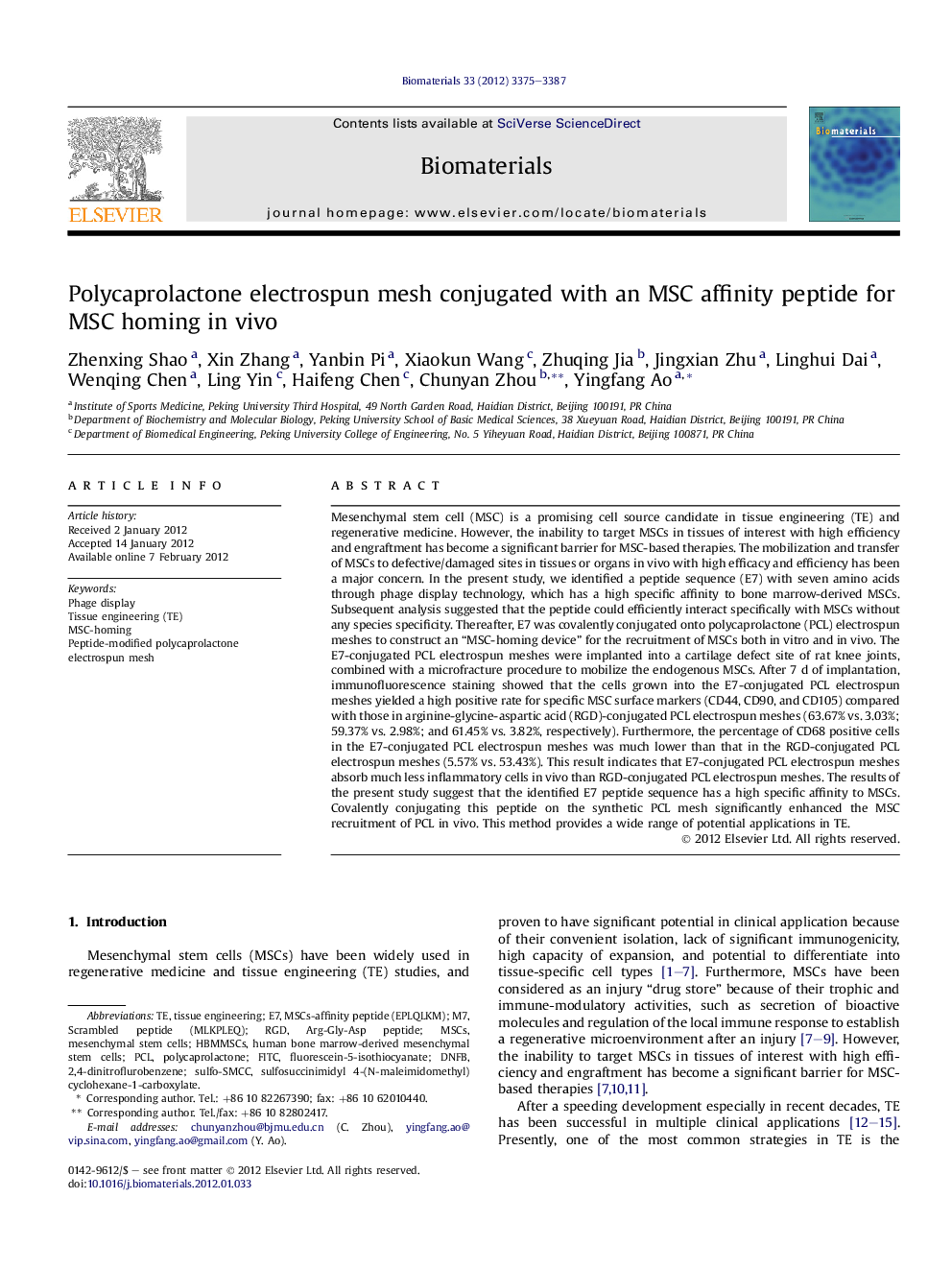| کد مقاله | کد نشریه | سال انتشار | مقاله انگلیسی | نسخه تمام متن |
|---|---|---|---|---|
| 10229365 | 521 | 2012 | 13 صفحه PDF | دانلود رایگان |
عنوان انگلیسی مقاله ISI
Polycaprolactone electrospun mesh conjugated with an MSC affinity peptide for MSC homing in vivo
دانلود مقاله + سفارش ترجمه
دانلود مقاله ISI انگلیسی
رایگان برای ایرانیان
کلمات کلیدی
موضوعات مرتبط
مهندسی و علوم پایه
مهندسی شیمی
بیو مهندسی (مهندسی زیستی)
پیش نمایش صفحه اول مقاله

چکیده انگلیسی
Mesenchymal stem cell (MSC) is a promising cell source candidate in tissue engineering (TE) and regenerative medicine. However, the inability to target MSCs in tissues of interest with high efficiency and engraftment has become a significant barrier for MSC-based therapies. The mobilization and transfer of MSCs to defective/damaged sites in tissues or organs in vivo with high efficacy and efficiency has been a major concern. In the present study, we identified a peptide sequence (E7) with seven amino acids through phage display technology, which has a high specific affinity to bone marrow-derived MSCs. Subsequent analysis suggested that the peptide could efï¬ciently interact speciï¬cally with MSCs without any species specificity. Thereafter, E7 was covalently conjugated onto polycaprolactone (PCL) electrospun meshes to construct an “MSC-homing device” for the recruitment of MSCs both in vitro and in vivo. The E7-conjugated PCL electrospun meshes were implanted into a cartilage defect site of rat knee joints, combined with a microfracture procedure to mobilize the endogenous MSCs. After 7 d of implantation, immunofluorescence staining showed that the cells grown into the E7-conjugated PCL electrospun meshes yielded a high positive rate for specific MSC surface markers (CD44, CD90, and CD105) compared with those in arginine-glycine-aspartic acid (RGD)-conjugated PCL electrospun meshes (63.67% vs. 3.03%; 59.37% vs. 2.98%; and 61.45% vs. 3.82%, respectively). Furthermore, the percentage of CD68 positive cells in the E7-conjugated PCL electrospun meshes was much lower than that in the RGD-conjugated PCL electrospun meshes (5.57% vs. 53.43%). This result indicates that E7-conjugated PCL electrospun meshes absorb much less inflammatory cells in vivo than RGD-conjugated PCL electrospun meshes. The results of the present study suggest that the identified E7 peptide sequence has a high specific affinity to MSCs. Covalently conjugating this peptide on the synthetic PCL mesh significantly enhanced the MSC recruitment of PCL in vivo. This method provides a wide range of potential applications in TE.
ناشر
Database: Elsevier - ScienceDirect (ساینس دایرکت)
Journal: Biomaterials - Volume 33, Issue 12, April 2012, Pages 3375-3387
Journal: Biomaterials - Volume 33, Issue 12, April 2012, Pages 3375-3387
نویسندگان
Zhenxing Shao, Xin Zhang, Yanbin Pi, Xiaokun Wang, Zhuqing Jia, Jingxian Zhu, Linghui Dai, Wenqing Chen, Ling Yin, Haifeng Chen, Chunyan Zhou, Yingfang Ao,